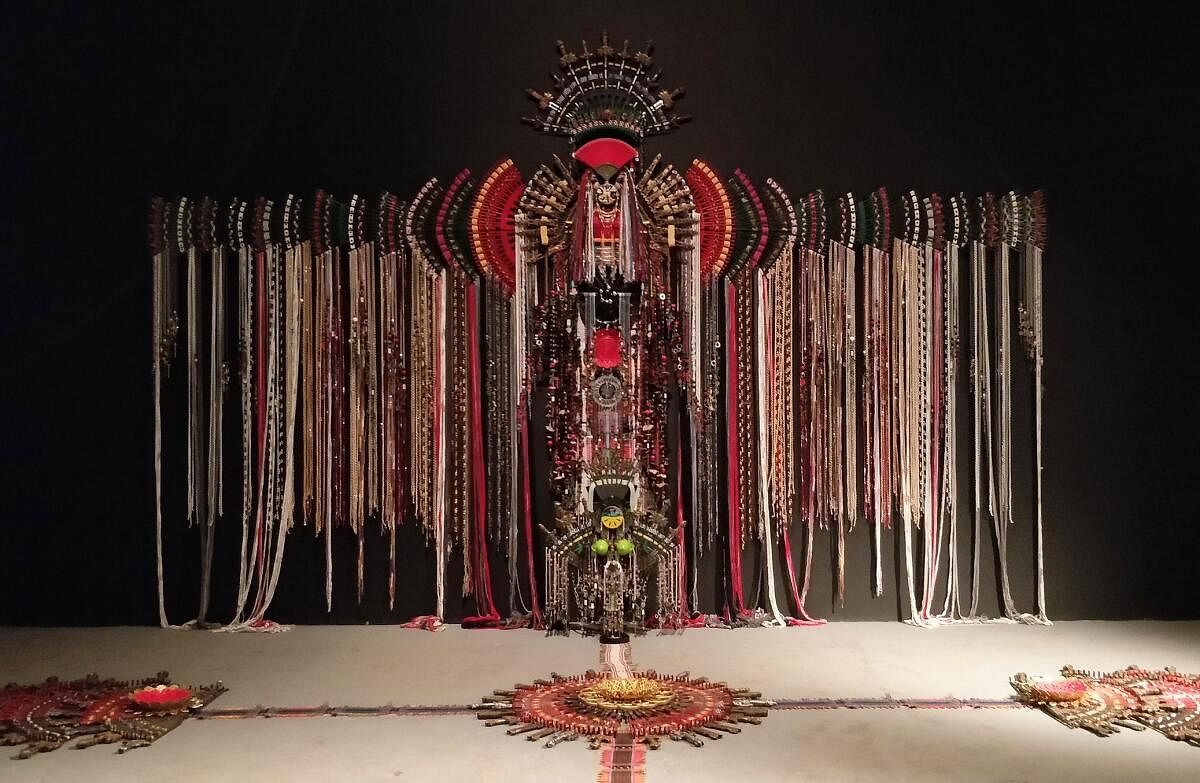
One of the most notable and visually arresting installations at the recently concluded Kochi-Muziris Biennale was Malaysian artist Anne Samat’s piece titled ‘Cannot Be Broken And Won’t Live Unspoken’.
Installed in a somewhat dark but monumental space that evoked the inner chamber of an indistinguishable temple, Samat’s large work recreated (an unnamed and ungendered) traditional Indian deity. As the visitor got closer, it became clear that the brilliantly colourful work was not made of wood, stone, or metal but with found objects and everyday materials.
With a six-metre wingspan that was constructed of rakes, metal colanders, rattan sticks, washers, plastic swords, toy soldiers, beads, and metal/plastic ornaments, the totemic work showed the artist’s strong engagement with both sculpting and weaving. In addition to the main piece, a sprawling assemblage was spread across the floor with an array of belts and textiles that represented simplified versions of lotus petals and flowers.
Beyond rules
Anne Samat (b 1973), who is half Malay, and half Chinese, is known for her practice that is deeply informed by Malaysian culture (in which she was born and raised). The uniqueness of her art practice lies in the way she infuses a contemporary touch and poetic feeling while combining traditional Pua Kumbu weaving with unconventional objects and materials. By doing this, she moves beyond the rules and acceptable practices of traditional weaving and constructs a creative bridge between tradition and modernity. “I mix modern materials with old-fashioned weaving, marrying the old and the new. By putting them together, I am trying to elevate the status of weaving to the highest level. That is my trademark.”
Samat whose works have become increasingly visible in international circuits in recent years has had an interesting life in and outside of art. Born into a large family (with nine siblings) she has vivid memories of growing up in a poor but caring household "in beautiful Malacca (in southwestern Malaysia), in a wooden house surrounded by rubber trees." Her artworks reflect deep recollections and associations of her younger days. Nuggets of familial history are embedded and embellished in her work as intricately woven structures and symbols.
“Many of the objects I use in my sculptures bring back humble, sweet memories of childhood. We were poor (financially and in material possessions), but rich in terms of love. Love is the legacy and foundation of my life and work. Love and spirits are the basis and core of my work.”
Human bondage
Samat particularly recalls her close bonding with her father who worked as a security guard to sustain his large family. Her work titled ‘Follow Your Heart Wholeheartedly’ (made of sticks, yarn, rakes, washers, plastic swords, toy soldiers, beads, metal, and plastic ornaments) shown at the inaugural Asia Society Triennial in New York in 2020 was dedicated to the memory of her father.
After studying science in high school, Samat changed tracks and went into art and design. For her graduate studies at Malaysia’s Universiti Teknologi Mara (UiTM), she chose to major in weaving, a subject she had no clue about. Eventually, she not only learned the skills, techniques and processes but also brought in her own innovations by incorporating unconventional materials into her weaving. She had to overcome the general bias against weaving which was not considered art but something akin to a pastime for old rural women.
In 1997, she won a young contemporary artist award from the National Art Gallery of Malaysia, a significant honour for an emerging artist in the country. She also found an admirer and mentor of sorts with painter and gallerist Raja Azhar of Artcase Gallery who not only encouraged her and mounted her exhibitions but also coached her in facing challenges as an artist.
Samat left for London in 1999 and held small independent shows. For 10 years, from about 2000 to 2010, she was a Formula 1 model in England — "one of the girls standing next to the racing cars." She recalls: “I had two careers and a partner, but something was missing.” She kept moving back and forth from Malaysia. Her solo exhibition at Richard Koh Fine Art in 2017 became a turning point in her career. Ever since, her works have found a place in prestigious fairs and exhibitions in Singapore, Hong Kong, New York, Basel (Switzerland), and Yokohama, among others.
With increased exposure, her art has also attracted critical attention and acclaim. “Samat’s work is meant to thwart the stable gears of the calm tradition,” says a reviewer. “Just as the search for self is a long and winding process for humanity, her monumental sculptures do not reveal their history and legacy immediately… Each work is foundationally unique; they each have their own story embedded. They are about love, individuality, and liberation.”
Powerful and gentle
Samat believes that being a Muslim and working in a country like Malaysia with its customs, traditions, and societal conditions can be very challenging. That possibly is the reason she continually shuttles between countries to pursue her creative interests.
She hopes that her work is not seen as something just beautiful but also powerful yet gentle. She feels that the uncommon objects in her works have unusual potential and produce an almost ethereal quality. She sees the importance and beauty in both the process and journey of art. “It’s not all about the destination; it’s about the journey, the process.”
Samat was overwhelmed by the response to her work at the Kochi Biennale. “The kind of passion shown by the people, the workers at various venues, and those behind the curtains is unparalleled. I have never previously seen the kind of love, enthusiasm, curiosity, and warmth in reactions in any venue as shown by the ordinary people who thronged the main venue on day one of the Biennale.”